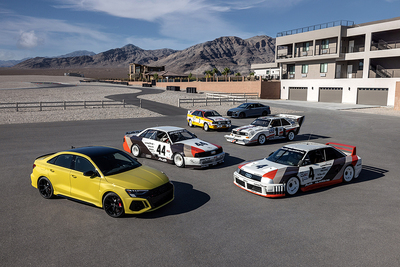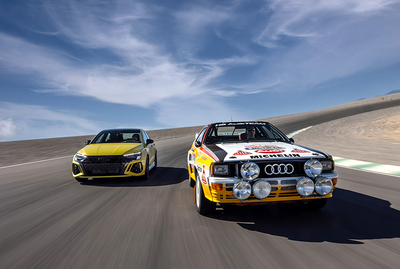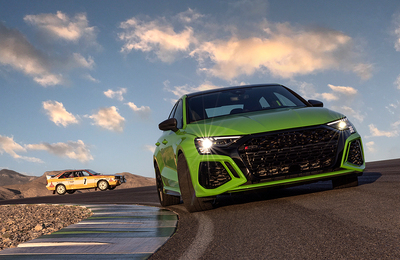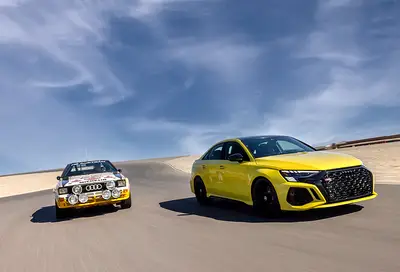How Legends Sound: The Revolution of the Audi Five-Cylinder Engine
• Legendary engine proves successful concept from racing to series production
• Five-cylinder engine returns with legendary performance in 2022 Audi RS 3
• Since 2010, 2.5-liter TFSI five cylinder engine voted “Engine of the Year” nine consecutive times
HERNDON, VA - June 19, 2022: Awaiting the arrival of the 2022 RS 3, Audi of America celebrates the historical triumph of the legendary five-cylinder engine. From the racetrack to the road, Audi’s five-cylinder engine presents unparallel performance and an iconic sound thanks to the uneven number cylinder configuration and the particular 1-2-4-5-3 firing order. The five-cylinder engine legacy story continues to be told, and is now available in the new 2022 Audi RS 3.
More power per liter
Audi has expanded its high performance downsizing strategy to the compact class, and fulfilled the blend of supercar performance matched with competent efficiency. The latest 2.5-liter
five-cylinder engine found in the 2022 RS 3 is now available with the highest horsepower performance of any series production Audi five-cylinder model. This impressive level of power output equates to 160.4
horsepower per liter, which endorsed the new RS 3 to set the lap record for compact cars on the heralded Nürburgring Nordschleife with a time of 7 minutes 40.748 seconds in June 2021 – matching
the original Bugatti Veyron 16.4 lap in 2005 of 7 minutes 40 seconds, exhibiting just 123.4 horsepower per liter at the time.
Most powerful series production five-cylinder engine ever
As the market transitions to the next era of motor development with electricification, the final version of the internal combustion engine is the
best it can possibly be – incorporating new tecnological advancements to improve efficiency and performance. In concrete terms, the five-cylinder engine in the all-new RS 3 has been optimized in several
different ways as it compares to the predecessor model.
Expanded power range: From 394 horsepower to 401 horsepower (+ 7).
-
• Increase in maximum torque: From 354 lb-ft to 369 lb-ft at 3,500 rpms (+ 15) contributing to a dramatically more steep performance curve
where maximum power is reached earlier and maintained longer than predecessor.
• Performance-optimized launch control: Provides improved acceleration from 0-60 mph than the predecessor – from 3.9 seconds to 3.6 seconds.
• Top track speed increase: Access to an impressive 180 mph – the highest top track speed of any Audi RS five-cylinder model ever.
Hear that sound? That’s legendary performance.
The Audi five-cylinder engines have achieved cult status – with deep historical roots in Audi’s DNA, and has become a fundamental pillar of the emotional Audi Sport brand. The engine has achieved
countless victories in motorsports as well as the “International Engine of the Year Award” nine times in a row since 2010 from an international jury of automotive journalists. Beyond its
accomplishments on and off track, the unique and distinctive sound of the five-cylinder engine is the attribute that most captures the emotion of enthusiasts. The 2022 RS 3 available Sport exhaust system
adjusts the engine tone for an even more aggressive sound that gives it the most intense and raucous sound ever heard from a series production Audi five-cylinder.
Legendary five-cylinder?
Challenged accepted. At the beginning of the 1970s, Audi engineers were challenged to develop a new source of engine power that could increase performance over a four-cylinder,
while maintaining efficiency. The six-cylinder engine was ruled out at the time due to engineering challenges with space, weight, and efficiency. The first five-cylinder Audi engine would power the 1976
Audi 100 (C2) with a 2.1-liter five-cylinder engine with 136 horsepower. The rest? Is legendary history.
Five-cylinder engine and quattro
The Audi five-cylinder engine and quattro all-wheel drive are legends with heroic history that defined their story collectively in the early 1980s. Today, the permanent
all-wheel drive system and legendary engine haven’t lost the spirit to captivate worldwide Audi enthusiasts.
-
• First five-cylinder Audi engine powers the 1976 Audi 100 (C2) with a 2.1-liter five cylinder engine with 136 horsepower.
• The original Audi “Ur-quattro” quattro would debut at the 1980 Frankfurt Motor Show with technological advancement for the five-cylinder engine with turbocharging, an intercooler, and Audi’s first permanent four-wheel drive.
• In 1983, Finn Hannu Mikkola won a driver’s title in the World Rally Championship with the Audi Ur-quattro.
• In the same year, Audi introduced the wide-track Sport quattro powered by a newly developed five-cylinder engine made of aluminum with 306 horsepower – making the Sport quattro the most powerful car for road use built to date by a German automaker.
• In 1984, Audi becomes the first manufacturer to optimize the five-cylinder engine with a fully electronic map-controlled ignition system and catalytic converter as standard – found in Audi 100 (C3), the Audi Coupe (B3), and in the Audi 90 (B3).
Group B rally did dominate
The Group B rally was remembered as one of the most fascinating and inspiring periods of racing competition – celebrated as the pinnacle of the World Rally Championship (WRC).
From 1982 to 1986, cars were allowed unlimited amounts of turbo boost and no weight restrictions resulting in radical performance.
-
• Legendary Audi Sport quattro forms the basis for a new Group B rally car delivering an astounding 450 horsepower at its first race in 1984 at the Ivory Coast rally.
• In the same season, the Group B Audi quattro A2 with 360 horsepower from the same five-cylinder race engine would go on to win the driver’s title, while Audi takes manufacturer title.
• In 1986, Audi withdraws from rally, but continues to define a legendary legacy.
• In 1987, Walter Röhrl wins Pikes Peak Hill Climb in the Audi Sport quattro S1 (E2) with 598 horsepower.
Trans Am series/IMSA GTO race scene
The IMSA GTO and SCCA Trans Am series was a North American sports car racing series that challenged limits of racecar technology and later served as the series that would ban quattro all-wheel drive from
racing – deemed as an “unfair advantage” after repeatedly dominating the racetrack. Audi racing champion, Hans Stuck goes on to say, “my mind races thinking about the countless
victories and successes Audi has had with the legendary five-cylinder engine. The combination of the five-cylinder paired with quattro was not only unique, but it was unstoppable.”
-
• In 1988, the Audi 200 quattro Trans-Am used the basis of a production five-cylinder engine for homologation purposes with up to 510 horsepower from a 2.1-liter engine – an impressive exhibit of 242
horsepower per liter.
• In 1989, the Audi 90 quattro IMSA GTO would dominate on the U.S. touring car scene with 720 horsepower from a 2.1-liter five-cylinder race engine.
• Audi would take home eight wins from the 13 events as champions Hans Stuck, Walter Rohrl, and Hurley Haywood made permanent impressions on all who could hear the unmistakable sounds of legendary performance from the Audi five-cylinder engine.
Audi five-cylinder revolutionizes road driving and lives on
In 1994, Audi would define a high-performance model line with the first series production RS-model – the RS 2 Avant. The RS 2 would present
an output of 315 horsepower as an Avant with the power of a sportscar. In 2009, Audi would implement TFSI turbocharging and gasoline direct injection with a transversely mounted engine in the TT RS developed
by quattro GmbH known today as Audi Sport. In 2012, Audi developed another remarkable feat in engine development when the 2.5-liter engine was the first gas engine in the world to use a compacted-graphite
iron cylinder block in the 2012 Audi TT RS, which also made its debut in the U.S. for the first time.
While 2022 is the last model year for the TT RS in the U.S., the model will live on in other international markets for some time. The Audi five-cylinder engine will forever remain a fundamental pillar for enthusiasts and collectors alike – celebrating the victory, performance, and expansive history for the Audi brand which will continue to be available once the all-new RS 3 goes on sale late summer 2022 in the U.S.








